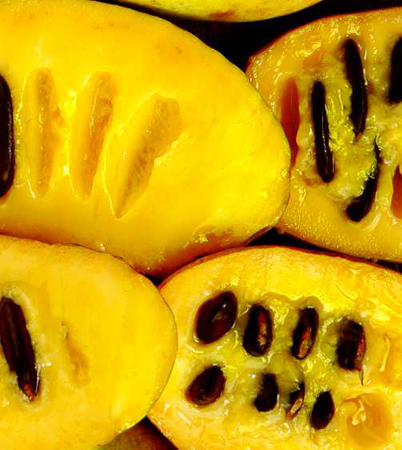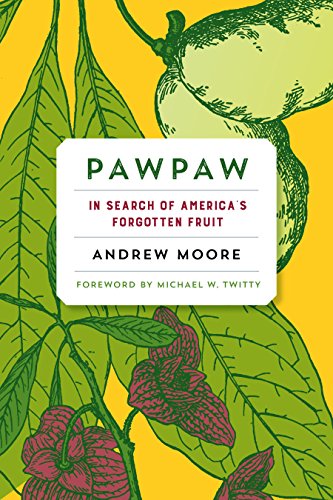Pawpaws crept into my garden ten years ago. Though they looked like normal, nursery-bought tree saplings, in reality they were borne to my New England home on a tide of lore, deep history and culinary curiosity.
I’d first heard of them during one of many stints on organic farms in the Southwest during the 1990s. Weeding our way down a long row of greens, I listened as a coworker reminisced about college days in Bloomington, Indiana, when, demoralized by dining hall food, he’d visited the little city’s fabulous farmers market in search of actual sustenance. There he discovered growers offering baskets of this strange fruit nicknamed the “Indiana banana,” and he became hooked on the exotic flavor and consistency.
Later I read about a slew of native North American fruits that long ago evolved to use large fruit-eating mammals to spread their enormous seeds. Animals like mastodons and giant ground sloths, which devoured the sweet produce of trees including the pawpaw, the continent’s largest native fruit, dispersed the seeds across the landscape in their rich dung, which helped the plants to sprout.
Following their partners’ extinction, pawpaws have since relied on humans to move across the landscape, first with native people who planted them along trade routes to cultivate places to snack while traveling, and much later with the aid of farmers and gardeners.

All this had gotten me really curious to taste one of these legendary fruits, which many describe as a cross between a banana and mango, despite others who insist there’s more pear or even pineapple flavor than mango in their flesh.
However, I was defied by the landscape itself. Pawpaws tend to grow from the Gulf Coast Plain to the Lower Midwest and Mid-Atlantic states. I had since moved to New England, an area where the exotic-looking trees are rare but will in fact grow and survive winter temperatures as low as minus 25. In fact, their seeds actually require a period of freezing (“scarification”) before they will germinate.
But due to a near complete lack of availability, pawpaws approach mythical status here. New England does have one well established fruit farm on the Rhode Island coast that sells them reliably each fall, and pawpaw devotees do often drive from as far away as Pennsylvania – a four-hour drive one way, at minimum – to wait in line before the farm stand opens on the few days each year that it offers the fresh ones for sale. That farm’s proprietor reports that the ripe fruit is normally gone within minutes.
One other major obstacle to greater pawpaw distribution is their notoriously short shelf life of just a few days: once they are ripe you must eat them fresh (with a spoon, as many folks prefer) or scoop out and freeze the flesh for subsequent mixing into ice cream, smoothies or more elaborate dishes. There are a number of farms that have dabbled with shipping them overnight to paying customers, and while some still do, the results can be mixed, with fruit arriving in various states of edibility (the Rhode Island farm ended this practice years ago now), and the cost was prohibited for this writer’s salary.
Those first bites lit my mind on fire. They absolutely did taste like a marriage of banana and mango, but I couldn’t quite square these exotic flavors with the autumn landscape I saw them spring from. I was hooked.
I realized I’d have to grow my own if I wanted to be certain about tasting one of these oblong beauties, and it was a shock when I started looking to mail order some young trees and saw pawpaws offered in the plant list of a nursery near me. I visited the operation and was surprised to see among the hardy kiwi, persimmons, and clumping bamboo varieties a stand of pawpaws about 20 feet tall and nearly as wide, their lush leaves enjoying the strong spring sunshine.
The proprietor grows saplings from seeds collected from fallen fruits and claimed they were a popular item, though not with him, since he’s part of the small slice of the population that’s allergic. I walked out with three one-foot-tall saplings, since two or more trees of the same variety grown from seed (or two or more varieties from grafted trees) are required for proper pollination. Though pawpaws are adapted to life in the shade of established tree canopies, they prefer full sun, so I made plans for them on the sunny south slope below the house.
After planting the trees, I settled in to wait 4 to 6 years for their first flowers, and, hopefully, fruit. Pawpaws flower late in spring, meaning they are less likely than apples, pears and peaches to be killed by late frosts. Flower they eventually did, at year 8: beautiful, deep red and slightly meat-scented, their petals designed to attract pollinating flies.

No fruit was set that year though, so I searched websites for the reasons for possible failure and read that you could hand pollinate them by swizzling a paintbrush in the flowers to spread pollen and increase the odds. Some folks even drape the branches with raw bacon to bring in more flies, though that increases your chances for broken branches from hungry raccoons and bears. I gambled and did that, but no fruit appeared. When the trees flowered the following year, I even placed a roadkill porcupine under their boughs to attract a fly swarm in addition to the paintbrush routine, but still I got no fruit.
In 2019, I resolved to not go crazy and just pollinated the lower flowers I could reach. I was delighted when several clumps of fruit formed, many of them above the reach of my brush, so the flies had done their job admirably, without me. (I later read that pawpaws may flower for a couple years before they decide they’re actually ready to set fruit).
I watched the fruit swell all year with anticipation, but my wait to sample their flesh had actually come to an end the previous fall, when I discovered a generous friend of a friend living just 20 minutes away who had begun his own pawpaw experiment years before mine and had sacks of them to share.
Those first bites lit my mind on fire. They absolutely did taste like a marriage of banana and mango, but I couldn’t quite square these exotic flavors with the autumn landscape I saw them spring from. I was hooked.
Call them Hoosier bananas, American custard apples, banangos or whatever you like. Eat them fresh or blend them into baked goods or ice cream (and even jam or beer), and I promise that you will find their flavor to be as unique as their story.

